



A grainly photo taken in MGC and another from F Coy group..
Quite a remarkable life of this man, whose life is stranger than fiction.
 |
 |
It is impossible to find a man with name Hallowell Carew in Birth Registers. However from putting together all the evidence one can draw his life together. The snippet of information from Ships registers include his married sister as his next of kin, and from her you can get the whole family including FMMH Carew here. He born Frank Murray Maxwell Hallowell Carew in 1866, probably ran into financial problems and changed his name to just Hallowell Carew, which he used from volunteering for the army in 1914 until his death in 1943. He indeed died officially as Frank M M H Carew. His file at Kew is available
1866 Jan 12. Born Frank Murray Maxwell Hallowell Carew in Carmarthenshire. Son of Benjamin Francis Hallowell Carew
1873 May 16 Francis Hallowell Carew, of Mount' Pleasant, Hyde, in tine Isle of Wight, Esquire, and Mary Fanny, his wife and Frank Murray Maxwell Hallowell Carew, an infant, by Robert Hallowell Carew, of Penzance, Esquire, his guardian, presented their Petition to the Right Honourable Lord Romilly, Master of the Rolls, praying that an Order might be made to sanction the scheme stated in the 10th paragraph of such Petition, for the construction of roads through the said demesne lauds,

1871 census the family living with a widowed mother in Broadlay and Ferryside, Carmarthenshire. The family consisted by now of Frank MMH, brother Guy, and 8 sisters.

1881 census, he was a 16 year old pupil at boarding school in Stubbington House Boarding School, Titchfield, Hants. Stubbington House School was founded in 1841, by Reverend William Foster, as "Foster's Naval Academy". The school gained a reputation, in the late 19th century, as "the recognized place for coaching towards a naval cadetship. One can note that one of his fellow pupils was Robert Falcon Scott, of Antarctic fame.
1883 enters Magdalene College Cambridge. Frank Murray Maxwell Hallowell. Carew. Admitted. pens. (age 18), July 24, 1883. S. of Francis Hallowell, deceased. Matric. Michs. 1883. He does not appear to last there as he is in the 4th Shropshire within a few months
1884 Feb 23. 4th Battalion, the King's (Shropshire Light Infantry), Frank Murray Maxwell Hallowell Carew, Gent., to be Lieutenant. Gazette This is a Militia Battalion. The King's Light Infantry (Shropshire Regiment) formed 1 July 1, 1881, as the county regiment of Herefordshire & Shropshire, part of the Childers Reforms. Renamed as The King's (Shropshire Light Infantry) in March 1882. The 1881 reforms redesignated the militia and rifle volunteers units within the regimental district as battalions of the regiment. The Shropshire Militia and Royal Herefordshire Militia became the 3rd and 4th (Militia) Battalions respectively. 4th (Militia) Battalions based at Hereford. On 11 March 1885 4th Battalion Shropshire Regiment Light Infantry one of the two best shooting (Militia) battalions with a figure of 79.84. 11 May 1885 4th Battalion Shropshire Regiment Light Infantry at Redhill for 27 days annual training and exercises
1886 Apr 8. Conveyance of a legal estate in the Carew Settled Estates by Alfred Mortimer, surviving trustee under the Carew Estate Act 1857, to Frank Murray Maxwell Hallowell Carew, eldest son of Benjamin Francis Hallowell Carew. Recites the Act of 1857, the financial history of the estates and the Carew family succession since the death of Charles H H Carew in Sep 1872. F M M H Carew wished to bar the entail on the estates, whereupon a deed of 12 Jan 1886 (details given) and an order of 6 Feb 1886 ruled that Mortimer should convey to him the legal estate in the trust properties, subject to certain annuities and portions to other members of the family (details). Schedule on 4 membranes gives full details of Carew estates in Beddington, Croydon, Mitcham and Walton on the Hill (rents, tenants, acreages) and of the Portobello Estate in Middx (house numbers, road names, lease details).
1887 Mar 24. He married Edith Morgan Gellibrand at St Margaret's Westminster. But does not appear to have been very fond of her (see below).

She was an actress who performed under the stage name Edith Chester. She is the "witty and amiable" daughter of the former Advocate General of Madras. There were 2 children by the marriage
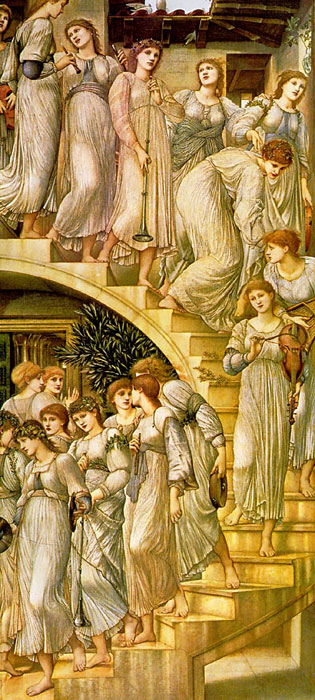 |
 |
The Golden Stairs |
Edith Chester |
The Golden Stairs is a painting by Sir Edward Burne-Jones as it is his ultimate expression of the aesthetic ideal of 'Beauty for its own sake'. One of the reasons for the popularity of the painting has been its apparent autobiographical character, as the various heads have been identified as portraits of the young women who influenced his life during the 1870s. At this time Burne-Jones's life was not a happy one, as he was recovering from a disastrous love affair with the Greek beauty Mary Zambaco. The Golden Stairs was conceived in 1872 and developed from 1876. In the late 1870s Burne-Jones prepared many sketches of drapery and figure arrangements. However, it was nor until 1879 that he decided to include the portraits of close female friends. According to John Christian the following girls can be identified in the painting: May Morris, Frances Graham, Margaret Burne-Jones and Mary Stuart Vortley. Other well known social beauties have been linked to the picture, including Laura and Margor Tcnnant and Mary Gladstone. It has also been suggested that Edith Gellibrand, who acted under the name of Edith Chester, is depicted.
They lived over the years before their divorce in 1890 at
1887 Jul 15 removed from 4th Shropshire Light Infantry for absence without leave
![]()
1887 Develops Northwood Station and surrounding area. Northwood Station. 1st September 1887, Between Moor Park and Northwood Hills on the Metropolitan Line. . So few passengers arrived in the early weeks that it was said that the line was doomed to failure. The station was the enterprise of Murray Maxwell Hallowell Carew. 'Northern wood', being to the north of Ruislip. ‘Northwode’ 1435 and there was a small Tudor village in the area.. This was the northern part of the rural parish of Ruislip where firewood gathering was an economic activity for locals and it was a pre-1914 Metroland development. David Carnegie JP put his Eastbury estate on the market on 25th March 1887 when the railway was announced. It was bought by Murray Maxwell Hallowell Carew, who claimed to be a son of one of Nelson’s captains, Carew sold the land of as building plots with a condition that houses should cost at least £750 except for cheaper cottages in the High Street. Roads were named after him and members of his family. From 1887 on, the modern Northwood developed. One of the first promoters was Mr Frank Murray Maxwell Hallowell Carew (1866-1943) and his sons Reginald and Roy. But for a difference this gentleman had with his wife, Dene Road would still be named Edith Road.

Note roads, Murray, Maxwell, Hallowell, Carew, Chester, Roy, Reginald, and Dene (was Edith)
An observation made at the time on Northwood Station . So few passengers arrived in the early weeks that it was said that the line was doomed to failure. The station was the enterprise of Murray Maxwell Hallowell Carew.

1888 Oct 9 He arrives in Zanzibar on a big game hunting expedition. During this expedition his rifle exploded and he had to be evacuated back to England. He successfully sued the rifle makers on his return.
1889 Jun 28
1890 Oct 24. His wife starts divorce proceedings against him
1890 Dec 17

1891 census, his wife Edith, is at 28 Addison Mansions, Hammersmith (only his wife in the census, and she born Russia) with her sister. But he is not there
![]()
1891 census shows him estranged from Edith and he is living elsewhere by himself at Albany Mansions, Charring Cross Rd

New York Times report
1892 Feb 5 Carew appeared in Court on an assault charge. He claimed Brandon Thomas had insulted his wife. Result of case was Carew was bound over on payment of £200.
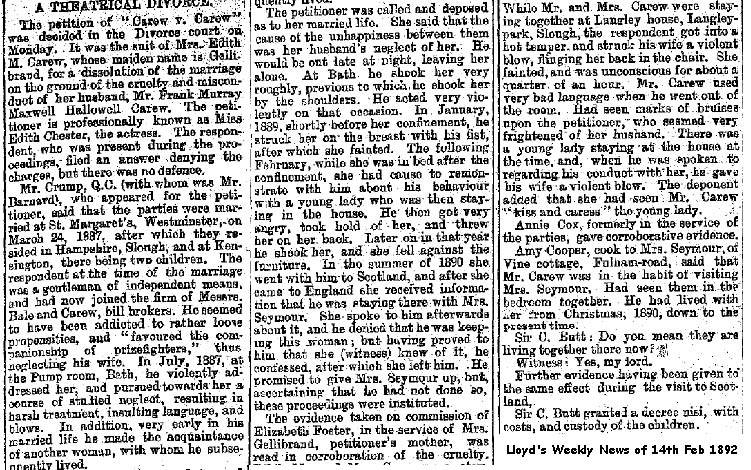
1892 Feb 8 decree nisi for the dissolution of the marriage on the grounds of cruelty and his adultery with Mrs Alice Seymour of 34 Sidney St, Fulham Rd (and later 17 Fawcett St, Redcliffe Gardens, Fulham. His wife described him as a man "of loose pursuits, who favoured the companionship of prizefighters, frequenters of racecourses and loose ladies who indulged in the midnight amusements of dancing saloons". This court case is as a result of a letter sent to the court by Vaile, who did not declare it, but was Carew's broking partner. She cites Carew's properties as

A Curious Divorce Case. A lady with a double. Australian Argus 1894 Feb 6
J.M.D. writing from London on November 30tb to the Argus says :- Another great case in the Divorce Court has just been concluded in a fashion worthy of the millionaire. " The Queen's Proctor intervened to upset the divorce granted some months ago to Miss Edith Chester, an actress, late wife of Hallowell Carew. The Queen's Procter alleged connivance, collusion, and so on. All ended delightfully. Even "the villain", the Queen's Procter, repented at the last.witb drew everything, and »as forgiven by the judge, the emotional special jury, and the public. Hallowell Carew, I fancy, I have described before at the time of the divorce and the assault which he committed on Brandon Thomas. A few years ago Carew succeeded to an income of £7,000 a year. He as done some big game shooting in Africa, in 1887 be married Miss " Edith Chester," a pretty and amiable actress daughter of Mr. Gellibrand, formerly Advocate-General at Madras.
Carew became one of the leading spirits of the Lyric Club. He was not suited for domestic and married life, and quarrels early took place between him and his wife. Her friends, that is to say everybody, bring against Carew the now customary charges in such cases. What is admitted on all sides is that a Mrs. Seymour intervened early to cause strife. She bears a curious resemblance to Miss Edith Chester, an accident often utilised on the stage. Whether Carew adored Miss Chester because she was like Mrs Seymour.or Mrs Seymour because she was like Miss Chester, ia not clear. They are both golden haired, and both wear innocent and winning smiles. The Queen's Proctor averred that from the very day the divorce was granted Mr. and Mrs. Carew continued on the most friendly terms, dined together, and otherwise ignored the legal proceedings. Some witnesses spoke to their dining together, but here Mrs. Carew's strange likeness to Mrs Seymour comes in. It is held that Carew and his friends dined with Mrs. Seymour, not with Miss Chester, on these occasions. A really original character, an . old . Irish Roman Catholic cook, who implored Miss Chester to take back her late husband because the Church abhorred divorce, gave evidence. The whole proceedings in this case tended to the greater glory of the stage. An officer of the Life Guards named Ellison went into the witness box to demonstrate that he had had tube honour of Miss Edith Chester's acquaintance, and offered his theory of this important case with great emotion. Lady James Douglas, widow of one of the Marquis of Queensbury's uncles, volunteered her opinion also, in order to put on record the fact that Miss Chester had stayed with her in Scotland. Mrs. Seymour is supposed to have carried Carew off somewhere to. marry him by force. She is a sort of South Kensington adventuress of a better sort.
The Queen's Proctor filled up the cup of his iniquities by finally bringing a charge of misconduct against Miss Edith Chester herself after the decree was granted. A Thames house boat called Ye Marye was brought on the scene, and two servants swear that they had seen Miss Edith Chester and a new character, Mr. Loftus Earle, sitting close to each other, on terms of theatrical friendship. This was too much for the judge and the special jury. They restrained themselves sufficiently to allow Miss Edith Chester to enter the witness-box to bewitch the whole Court, counsel, solicitors, and reporters included, and to deny everything. Then Mr. Justice Barnes and the special jury simply looked at Montague Crackentnorpe, who was for the Queen's Proctor, as much as to ask whether he wasn't ashamed of himself ; Montague Crackenthorpe was ashamed of himself, and at once withdrew all his charges in the handsomest manner. They say that Edith Chester's idea is to get married again. Loftus Earle, by the way, figured in the Clancarty divorce case. It was he who indignantly denounced "Marmy" Wood for mentioning at the Lyric bar that he and Lord Danlo had tossed a coin, heads or tails, for the right to marry Miss Bilton. A much more sensible plan, of course than fighting a duel about her.
Interestingly she does marry Loftus Earle in 1894, but appears to have reverted to Hallowell Carew by the time that she dies.

1892 Feb 29 From London Gazette Notice is hereby given, that the Partnership which has for some time past been carried on by Reginald Francis St. Fere Vaile and Frank Murray Maxwell Hallowell Carew, under the firm of Vaile and Carew, at 71, Cornhill, in the City of London, in the , trade or business of Bill Brokers, Bill Discounters, and Money Dealers, was this day dissolved, "by mutual consent, as from the 29th day of February, 1892.; the said Reginald Francis St. Fere Vaile assuming the liabilities and assets of the firm.

1893 Dec 12. Carew is told he has to pay his wife's debts prior to his divorce. She received an allowance of £259 per year from his income of £7000 a year, a tidy sum in those days
1894 has a marriage of Frank Hallowell Carew to either Florence Harriet Rhind or Ada Waterer (one would need the cert to be sure)
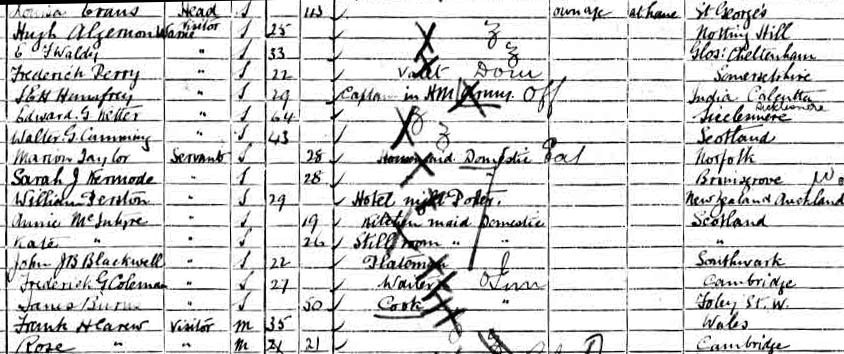
1901 census he is staying at British Hotel 82/83 Jermyn St, London with a Rose Carew aged 21. (it is not a sister, no Rose Carew born around 1880, and no sign of a marriage of a Carew to a Rose). The implication is that he was not married to young Rose, whose surname is not known. The British Hotel is now the Cavendish Hotel. His two sons are at Burlington House School in Richmond, Surrey
1911 census Carew is living by himself in Chelsea (He says married but I cannot find his wife) Born circa 1868 at Ferryside, Carmarthen. Of independent means.
1913 Mar 12 Frank Hallowell Carew arrives in New York from Liverpool on SS California. Age as 25, status as married
1914 Nov 2. Joins up. The undermentioned temp. Lts., from 1st Battalion M.G.C. (Motor), to be temp. Lts. 18 Nov. 1916, but with seniority from 2 Nov. 1914. This is a Service Battalion.

I was sent this photo of 16th Motor Machine Gun Battery (Motor Machine Gun Service) which was published in The Motorcycle newspaper 19th August 1915. The photo taken probably June or July 1915 at Bisley. The OC and three section officers are named in the caption and he's noted as Lt Carew. He has to be the one on the left (1st Section) as I have identified the other two much younger 2nd Lieutenants.
The Battery went to France on 29th July 1915 and this matches date of entry on Medal Index Card - so certainly him. MMGS were taken over by the Machine Gun Corps when they were created in late 1915 and became MGC(Motors). He appears on the army list 1916 in the Motors section as Lt with seniority 2nd November 1914 and this indicates him joining MMGS as they formed. He's noted in the war diary and served with the battery until they were disbanded in November 1916. He and one of the other officers and most of the men transferred into Machine Gun Corps Heavy Branch in November 1916 when they expanded the tank companies into battalions.
1915 Jul 29. Disembarked at Havre, France
1915 Nov 5. Granted one weeks leave in England.
1916 May 6. Granted one weeks leave in England.
1916 Nov 8. Joined Base Depot MGC
1916 Nov 16. Posted to A Battalion, Heavy Branch, in the field.
1916 Dec 1. Granted 10 days leave in UK
Originally formed as Companies of the Heavy Section MGC, designated A, B, C and D, each Company consisted of 4 Sections of 3 tanks of each type (male and female Mk 1's). Companies also had another machine in reserve. In November 1916 the Companies were expanded to Battalions, carrying the same letter designations. A Battalion consisted of 3 Companies. Three mobile workshops provided the engineering back-up to service the tanks.
An expansion programme was ordered by GHQ, to build a force of 14 additional Battalions. The Tank Corps was formed from the Heavy Branch MGC on 27 July 1917 and the Battalions adopted numbering rather than letter designations (although tank names followed the same lettering: for example, 7th Battalion tanks were all named with a letter G, like Grouse, Grumble, etc.) Each Tank Battalion had a complement of 32 officers and 374 men. The basic structure of command was that each tank was crewed by a (2nd) Lieutenant with an NCO and six soldiers. A section of four tanks was commanded by a Captain and four sections made up a Company headed by a Major. The Battalion was commanded by a Lieutenant Colonel and consisted of three Companies.
By summer 1917 tank numbers had increased and the better Mark IV's were available. The tanks deployment in the Third Battle of Ypres (July-November 1917) proved to be another slog through deep mud. The area became a tank graveyard as machine after machine ditched in deep trenches and shell holes, sank, stuck and was shelled. Morale in the Tank Corps was low and confidence of the rest of the army destroyed. Although there was a bright incident when tanks did well at St Julien, the tanks needed to be given a fighting chance.

A Mark IV female tank of A Battalion at the Rollencourt Tankodrome on 18 June 1917.
1917 Jan 17 Decri Nisi in divorce with Alice Caroline Carew.
1917 Summer . Lt K.E. Wooton's diary Jack was Officer Carew’s dog, a white fox terrier who was aboard our tank al lot of the time. He often took a walk in to no mans land and wished to make the acquaintance with another dog on the other side who had caught his eye. He had no trouble in walking the 100 years to the other side and had no fear. We watched him and admired. At Ypres in the summer of 1917 he jumped on to a lorry. This was the last we saw of poor jack. Carew was inconsolable and after endless enquiries we found out he had been killed by a shell.
1917 Jul Lt K.E. Wooton's diary wrote: 'My driver Fagg could be seen anxiously peering through the half open window in July 1917 at the Third Battle of Ypres. I lit a cigarette as my mouth became quite dry, I lit another, it tasted rotten but I smoked it somehow as we got nearer the lines of burning shells. 'We escaped with nothing more than lumps of earth falling around us. The German front line had been smashed almost out of recognition as we passed through shell holes and most were filled with filthy water and bodies. 'Up the hill Fagg and I felt we were in for it as the Germans still held Westhoek and Gelncorse wood. I was kept busy dodging from side to side on my tank as a great many shells fell around us. I should have got inside but I hate being boxed up in the stifling heat of a tank. I felt safer in the open. 'Captain Carew, our section commander dashed madly about to try and get our tank up to an impossible speed. He imagined a tank could behave like a new motor car. Heavens, how heart breaking it was to guide a tank over the frightful ground. Long lines of mules followed us carrying shells and stumbling over the broken ground. Daily Mail News Article . Wooton wasa Second Lieutenant about mid July 1917 and he commanded Mark IV Male 2027 A28 "Amulet" of 6th Section 2nd Company A Battalion on the opening day of Third Battle of Ypres, 31 July 1917. His section commander at the time was Captain Carew (DM has it as Crew)

Sketch from Lt K.E. Wooton's diary
1917 Jul. Citation for MC "T./Capt. Hallowell Carew, Tank Corps. For conspicuous gallantry and devotion to duty. He personally led his section of tanks on foot to their objective under very heavy shelling and intense machine-gun fire. He displayed admirable coolness and courage, .going from tank to tank and helping them out of difficulties, and it was entirely due to 'his total disregard for personal danger that they were able to reach the infantry when the latter were held up. Before the action he carried out several good reconnaissances (under heavy shell fire.) Citation came in LG 7 Jan 1918

1917 Nov 20. He is shown as section commander of No. 6 Section, 2nd Company of A Battalion at Cambrai. However there is no account of any specific activities there.
1918 Sep 6. To be an Acting Major while commanding a company. Temp. Capt. H. Carew, M.C.
1918 Sep 29. War Diary of the 4th Battalion, it says that A Company, under the command of Major H Carew, M.C., were in action, supporting the 27 and 30 American Divisions in their attack upon the Hindenburg Line and the Bellicourt Canal Tunnel, part of the battle of the St Quentin Canal. After the tanks had silenced the German machine guns at Guillemont Farm they began to retire from the action, but unfortunately they had been given the incorrect location of an anti-tank minefield, laid by the British prior to March 1918. One tank had wandered into the mine-field on the advance, but three tanks struck the field on the return journey, wounding 3 Officers and 15 men, plus killing two men.
1918 Oct 22. Tank Corps Temp. Capt. H. Carew, M.C., relinquishes the acting rank of Major on ceasing to command a Company.

1920 Apr 12. In command of tanks in Dublin, This incident was during the hunger strike at Mountjoy

1920 Jun 1 . Special Appointment Class. GG. Temp. Capt. H. Carew, M.C., Tank Corps. On the establishment of Intelligence Officers in Ireland.
Major Carew was an intelligence officer who with Captain Gilbert Price had cornered IRA gunman Sean Treacy the month before. Price (Price is not the same man as who was murdered at 28 Upper Mount St) was shot by mistake by a passing British patrol coming on the scene. Treacy was also killed, but Carew managed to avoid death. The operation in Talbot St. was made of 1 officer, 20 other ranks (Lancs Fusiliers) and an armoured car being sent from the Castle to Talbot St. "On arrival the alarm was given and it has been since ascertained that one of the rebels deliberately exposed himself in the street, opening fire to divert our attention. Fire was also opened from the house. This man (Treacy) was killed and also several other civilians. Of the Crown forces, one was killed and 3 wounded."
1920 Nov 20. On Bloody Sunday Carew was living at 28 Upper Mount St, just across the road from 38 Upper Mount St and the shootings of Ames and Bennett. His batman, Private Lawrence, saw the raid and when he alerted Carew, Carew fired with his revolver at the attackers.



He was one of the men on the hit list but when the IRA came calling for him at number 38, but he had moved to an apartment across the street the day before. He heard the gunfire at his former lodging and began firing his own revolver at an IRA sentry outside. The sentry, Lawless, took cover inside the house. Carew's action prompted the IRA gang to clear out. Patrick Moran was charged with the murder of Lieutenant Ames at 38 Upper Mount Street on Bloody Sunday along with another man called Joseph Rochford. Moran was identified by three British soldiers as taking part in the shooting - they were Major Carew (who lived as 28 Upper Mount St - on the other side of the street from 38), Private Lawrence and Private Snelling. However, Carew was not prepared to swear positively that the man he saw was Moran. The evidence from Lawrence and Snelling however led to Moran being found guilty and sentenced to be hung. Moran in fact led the IRA group who killed two men in the Gresham Hotel on Bloody Sunday. Moran was captain of D Company, 2nd Battalion, Dublin Brigade, IRA. It is ironic that he died for the wrong crime.
Carew's witness statement at Moran's trial reads
On 20th November 1920 my servant Private [Lawrence] was very late returning home. I looked out of my sitting room window which is on the top floor and looks on Upper Mount Street and saw him talking to two civilians near the front door. Directly I looked out they left him and he came upstairs and made a report to me.
Next morning between 9 and 9.30 am I was in bed when my servant ran in and and told me something. As a result of which I got out of bed and took my automatic with me which I had under my pillow and went to the sting room and opened the window
At the house opposite I saw a civilian holding up a soldier. In his hand he had a Webley pistol. I cannot swear to him positively. Shortly after the soldier and the civilian disappeared into the house. I heard several shots. 15 or 20 ran out of the house. I fired at him and he fired at my window. I think I hit two as I saw them squirm but they ran on.
A Witness Statement by one of the IRA men Michael Lawless says "I went to the door to see across the road another British soldier shooting down the street at the backs of retreating Squad with what appeared to be a .22 automatic. We both fired and he jumped in through the doorway of his house. Afterwards we learned, much to our disappointment, that Major Carew, a much wanted Intelligence Officer, was living in the house opposite, and the soldier firing was obviously his batman."
1921 Jan Temp Capt H Carew relinquishes the acting rank of Major.
In a book by William O'Brien, an Irish Trade Union leader, says
Another officer came along and said to Major Carew : "What are we going to do with this fellow? " pointing to me. " Mr. O'Brien and I are going down to have lunch," said Major Carew, very coolly. We had a small restaurant on the ground floor in Eden Quay, and we went down. He, or some of his officers, had been there and told the man in charge, Wilson, that they would all have lunch there. I sat at the table and had lunch. All the officers went off afterwards, except one, who apparently remained there for my benefit ! The raid commenced precisely at twelve o'clock and lasted until about 5.30 pm In the meantime we had a meeting arranged for twelve o'clock. Joseph McGrath was to be at it. He was manager of our health insurance department. Cathal O'Shannon was to be there also. They were a bit late and when they arrived the place was surrounded, not only by the Black and Tans , but by a huge number of people looking on. "
1921 Feb 3. Severely wounded and gets gratuity of £104 for his wound from the army, plus £1500 from a Civil Court in Ireland for "malicious injury". His army wound gratuity was later increased to the maximum allowed of £250, but he did not get a wound pension. He was sitting in the Dublin Bread Company tea shop at 33 Dame Street in Dublin (quite a well known place in its time, it even features in one of James Joyces works). At 4.15pm he ordered tea. And as the waitress moved away a man approached him and deliberately fired once at Carew with an automatic pistol. The bullet hit him in the arm, he became unconscious and was taken away on a stretcher.


This is only 100 metres from the gates of Dublin Castle, between the Castle and College Green. A friend with Carew, attempted to grapple with the assailant, but the man escaped. Sturgis has the incident in his diary, saying that Carew was meant to be giving evidence at a court -martial the next day (does not say which case) and that that trial had to be postponed. In fact this was Moran's trial for the murders at 38 Upper Mount St opposite Carew's lodgings. The trial, due to start on 4th February, had to be postponed, and it started on 15th February 1921.
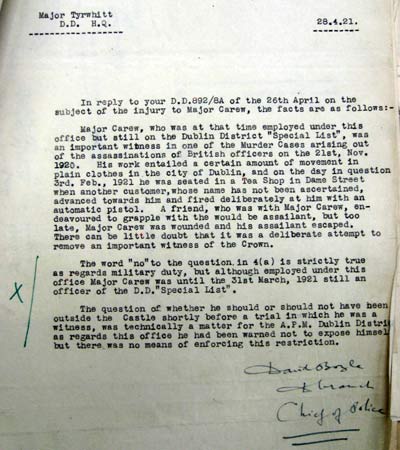
1921 Feb 4 the Baltimore Sun carries a report of an attempted assassination of a policeman in a Dublin restaurant. No casualties have been reported. Major Carew an auxiliary policeman dressed in "citizen's clothes" was in a restaurant in Dame Street this afternoon. W.S. no 707 by Michael Noyk, the Solicitor who defended Moran, states " I may mention that on the second morning of the trial ( Moran) there was excitement caused by the fact that Major Carew was not available. He turned up later with his arm in a sling and it was ascertained that he had been shot at while having tea in the basement portion of the then D.B.C. Tea Rooms in Dame Street while on his way to the Castle. From enquiries made by me, it was apparent that the shooting was not done by the I.R.A, but was obviously done by the British Forces"

1921 Apr 1. Tank Corps. Temp. Capt. H. Carew, M.C., relinquishes his commission on completion of service, and is granted the rank of Major.



1921 Dec 17 IRA Intelligence report

1922 Mar 18 He gets a job in Palestine Gendarmerie. The Palestine police force was founded in July 1920 at the time consisted of 18 British Officers supported by 55 Palestinian Officers and 1,144 rank and file, A Job Well Done: A History of the Palestine Police Force 1920 - 1948 Horne, Edward (too expensive for me at £60)
1922 Mar 22. Leaves UK on "SS City of Exeter" Major H Carew, of Wellington Club Grosvenor Place, London travels 1st class to Port Said. He is described as a Policeman bound for Palestine. Also traveling with him is Capt Howard Douglas Tiley also ex-ADRIC bound for Palestine
1922 Mar 18. Arrives in Palestine and joins British Gendarmerie
"Policing Palestine" by James Barker has a snippet of our man in action. "Carew [the local British Gendarmerie commander] then ordered them to unfix bayonets and clear the streets with butt ends if necessary. In 2 minutes the show was over and not a Nablusie to be seen, except those lying on the floor! No further trouble anywhere and [Wyndham] Deedes [Sir Herbert Samuel's Chief Secretary] told me later in the day that it had had a very good effect all over Palestine."
In another episode Carew, known locally as "Mad Carew", defied McNeill's order to discard his polo helmet on parade, and instead marched his men off the parade. It is not known if he was disciplined for this action.
1926 Jan 12. He returns from Palestine on leave and does not return to Palestine as his contract with British Section of the Palestine Gendarmerie runs out at the end of his leave on 11 April 1926
1926 May 1 two liners managed to leave England before the General Strike took effect and were due in New York May 9. One of them was the Adriatic which left Liverpool and amongst the passengers mentioned was a Major Hallowell Carew, aged 54 (born c1872), intending to stay at the Commodore Hotel, New York. He was 5’9” dark complexion, black hair and brown eyes. Address: Wellington Club, Grosvenor Place, London
His nearest relative was listed as his sister Lady Jerningham, Baylis House, Slough. Lady Jerningham was the 2nd wife of Sir William Henry Stafford Jerningham, 11th Baronet, but she was born Coralie Hallowell Carew daughter of Benjamin Francis Hallowell Carew of Beddington Park, Surrey. Benjamin and his wife (Mary Fanny Cornewall) had at least 10 children but only two boys Francis and Guy. Francis was Frank Murray Maxwell Hallowell Carew whose birth was registered in Ferryside, Carmarthenshire in the March Qtr of 1865. He appears variously as Francis M H Carew, Frank H Carew or Frank Carew in the various census returns and his year of birth wobbles a bit.
1926 Nov 15. Hallowell Carew of Grosvenor Place, London leaves New York and arrives in London on SS Minnewaska. Aged 48, ie born 1878 of birth from 1868 to 1871. His father was a retired army officer.
1927 May 7. Leaves Liverpool on SS Regina and arrives Quebec giving his destination as Chateau Frontenac, Quebec,. Given as aged 54 (ie born 1873) and says born Newton Abbot. NOK: Sister Lady Jeningham, Queens Terrace, Windsor, Eng. Carrying £150. And occupation as Army. The link back to his sister makes his birth at Newton Abbot impossible, so I have discounted it.
1927 Aug 14 Hallowell Carew was back in the UK when he arrived in Plymouth from New York on the SS Pennland. He gave his age as 51, born c1876.
1938 Jun 7. removed from reserve of officers on reaching age limit
1939 Applies for a job in the Army in WW2
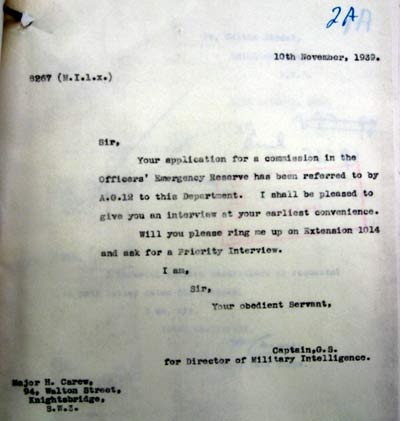

His son Reginald had been a rubber planter in Borneo, and this may well be why Major Carew claimed knowledge of the Malay States
1943 Jan 28 The Times reports the death on the 28th January 1943 of Major F Hallowell Carew OBE MC son of the late Francis Hallowell Carew of Beddington Park. Private funeral and no other details. The death of Frank M M H Carew was registered in Berkhamstead in the March Qtr of 1943, age 77 (ie born 1866)
![]()
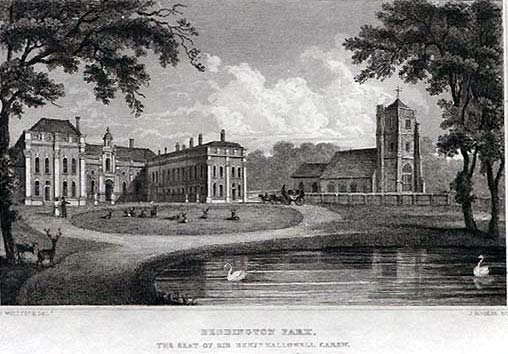
As a footnote to Hallowell Carew's life